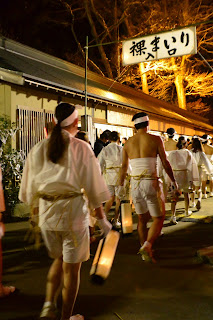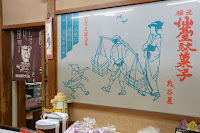Reporter: Pasith Tangdhanakanond(Thailand)
Three
Centuries Dessert Store:
Around the late
afternoon of a freezing day in the Sendai winter, we started our trip by
visiting a famous dessert shop. The shop name was “Sendai Dagashi Honpo
Kumagaiya”, which spans more than three centuries from Edo period. From the outside, the store was smaller than
expected, the building looked old, and had a very small entrance at the front,
but narrowed deep inside. We met with Mr. Norihiro Kumagai, the owner of the
store, a wise-looking middle aged man. As soon as I realized that his last name
matches with the store name, I was informed that he is the 10th generation of
the store owner. He started by telling us the back story of the snacks.

10th generation of the store owner, Mr. Norihiro Kumagai.
Sweets were a rare commodities. He told us that the snacks back then was made from whatever ingredients they could find, for example, rice and soy beans powder. They also made the snacks hard in texture, large in portion, and as sweet as possible as it would last long in the mouth. Many of desserts in this shop evolved into smaller size and became softer in texture in order to suffice the demand of the modern customers.
This is a very
different experience for me. In my country, we have many traditional desserts,
local and nation-wide, dated back as old as Edo period. Although changing or
evolving the dessert might be the key for the store to survive for three
centuries, we never tried to change or evolve them. The approach in making
snacks might change due to easier access to ingredients, but we would still keep
it as original as much as possible. If the store decided to implement on a traditional
dessert, that store would be shutting down within less than a year.
 After we finished on
the dessert, Mr. Kumagai started to talk about the store and area around it. I
saw a chance, and mentioned about the unique structure of the store. He
explained that the design is the traditional house design in Edo period. Having
small entrance can avoid tax collections from the government officials. He then
pointed out that this area is an old town, and my observation confirms his
word. Many buildings had the same structure as the store, small entrance but
narrowed deep inside. Mr. Kumagai also explained that the road in front of the
store is the key factor that makes his store thrives for three hundred years.
The road used to be the main route leading to Edo. People in these areas would
use the road, and stopped by at the shop for breaks. The conversation was
interesting, and the topic got broader. Mr. Kumagai showed us how we can
identify if different areas in Sendai were lived by Samurai or peasants by
simply just looking at the Kanji at the end of the name. He then blew my mind
by telling us that the slogan of Sendai, 杜の都,
did not come from the fact that there are many trees in the city as it says on
the advertisement media of Sendai city. The slogan is credited to Date
Masamune, who ordered the construction of man-made water ways in order to aid
farmers and locals. Because the water ways ran throughout the city, the whole
areas were covered by trees as if the city itself was a forest.
After we finished on
the dessert, Mr. Kumagai started to talk about the store and area around it. I
saw a chance, and mentioned about the unique structure of the store. He
explained that the design is the traditional house design in Edo period. Having
small entrance can avoid tax collections from the government officials. He then
pointed out that this area is an old town, and my observation confirms his
word. Many buildings had the same structure as the store, small entrance but
narrowed deep inside. Mr. Kumagai also explained that the road in front of the
store is the key factor that makes his store thrives for three hundred years.
The road used to be the main route leading to Edo. People in these areas would
use the road, and stopped by at the shop for breaks. The conversation was
interesting, and the topic got broader. Mr. Kumagai showed us how we can
identify if different areas in Sendai were lived by Samurai or peasants by
simply just looking at the Kanji at the end of the name. He then blew my mind
by telling us that the slogan of Sendai, 杜の都,
did not come from the fact that there are many trees in the city as it says on
the advertisement media of Sendai city. The slogan is credited to Date
Masamune, who ordered the construction of man-made water ways in order to aid
farmers and locals. Because the water ways ran throughout the city, the whole
areas were covered by trees as if the city itself was a forest.
After living in Japan for a while, I started to get
used to companies that are centuries old. There are many articles out there
explaining and analyzing how these companies thrive for hundreds of years. However,
meeting the store owner in person and had a valuable chance to exchange the
conversation is very different. These stories that Mr. Kumagai shared to us are
stories that even Sendai locals would be surprised. It shows that it took more
than being an heir to the Kumagai family to be the store owner. I also finally understood
that the point is not about changing or evolving the desserts. It is also not
about keeping the originality. When people buy the dessert from the store, they
are supporting the history. They embrace their identity, and pass on their
cultures to other people including the next generations.
Dontosai: The Half
Naked Pilgrimage
The
next destination of the trip was a Dontosai Festival at Hachiman Shrine. This
was my first time going to the festival because I usually stay home to avoid
the cold. I heard that the festival has huge bonfires and half-naked
pilgrimages.
At
the Hachiman Shirne, the street was lit-up by the Japanese style lamps along
the way with many stores actively selling food serving hot for the crowds who
were out in the freezing cold weather. As we approached the gate of the shrine,
the people were squeezed into a smaller area, and the area got so dense that
the people could no longer walk to the food stall and purchase the items.
Despite the crowds, there was one special route left open for parades of
half-naked pilgrimages. The parades constantly arrived the shrine, and ran up
to the destination via the express route. Seeing more than half of their
bare-naked body exposed to the freezing cold air, I couldn’t imagine how cold
it must be. I could only wish them best of luck, and hope they do not get sick
afterwards.
Although
the weather was sub-zero, people still dressed half-naked and exposed their
skins to the cold air. Some said this is some sort of training, but I have seen
other similar behaviors of Japanese people. For example, Japanese people prefer
to eat ice-cream in winter and go mountain hiking in summer. In my country, we
have tradition of eating ice-cream, drinking cold beverages, and splashing the
water in summer. In winter, we eat hotpot and stay warm as much as we can
inside the building. It is very interesting to see opposite reactions.
In
my limited knowledge, I have never heard of any other places where they might
have similar tradition. In my country, we normally throw unwanted items in the
bin. I am sure many foreigners would be confused to see a festival for throwing
away unwanted items. For me, I think it is a cool concept to create an
opportunity where everyone can get rid of their unwanted belongings. Letting go
is an important part in life, and it is not always easy to do so. Having a
lively and holy festival like this makes it easier, and reminds us that
everyone is experiencing the feeling, everyone is letting go of their past
together.
「元祖仙台駄菓子本舗 熊谷屋」と「どんと祭」
リポーター:パシット・タンダアナアカノン(タイ)
3世紀続く老舗駄菓子店
冷え込んだ夕方の仙台の冬、有名な駄菓子店を訪れることから私たちのリポートが始まりました。お店の名前は“仙台駄菓子本舗熊谷屋”、江戸時代から3世紀以上にも及ぶ歴史あるお店です。
外観のお店は予想よりも小さく、建物も歴史を感じる建物で、間口はとても狭いものでした。しかし、中は細長く奥行きがありました。私たちはお店の店主である、経験豊富で聡明な風格の男性、熊谷典博さんに会いました。熊谷さんの苗字がお店の名前と同じであることにすぐに気が付くと、熊谷さんはお店の10代目店主であることを教えてくれ、仙台駄菓子の背景を語り始めました。
菓子はとても貴重なものでした。当時の菓子は見つける事ができるどんなものでも材料にし、作っていました。例をあげるとお米やきな粉です。そして、食感は固く、1つあたりの大きさが大きく作られていました。それは、お菓子が口の中でできるだけ長く残っているようにするためでした。お店に並ぶたくさんのお菓子は、現代のお客さんの多くの要望に応えるため、小さなサイズに形を変え、食感も柔らかくなりました。
 熊谷さんはお店で仙台駄菓子の中でも歴史があり、進化を遂げた2種類の駄菓子を温かいお茶と共にご馳走してくれました。1つは大豆から出来ているものと、もう一つは小豆から出来ているものです。食感は本当に柔らかく小さなサイズで、一口かじるにはちょうど良い大きさです。しかし、この甘さの程度には意表を突かれました。私の母国、タイのお菓子のイメージがあり、もっと甘いものだと想像していたからです。とはいえ、砂糖のような甘さではなく、お菓子はとてもヘルシーで高級な感じがしました。材料はすべて自然なもので、おしゃれなお皿に盛り付けられ、熊谷さんの素晴らしいお話しと温かいお茶でいただきました。
熊谷さんはお店で仙台駄菓子の中でも歴史があり、進化を遂げた2種類の駄菓子を温かいお茶と共にご馳走してくれました。1つは大豆から出来ているものと、もう一つは小豆から出来ているものです。食感は本当に柔らかく小さなサイズで、一口かじるにはちょうど良い大きさです。しかし、この甘さの程度には意表を突かれました。私の母国、タイのお菓子のイメージがあり、もっと甘いものだと想像していたからです。とはいえ、砂糖のような甘さではなく、お菓子はとてもヘルシーで高級な感じがしました。材料はすべて自然なもので、おしゃれなお皿に盛り付けられ、熊谷さんの素晴らしいお話しと温かいお茶でいただきました。
これは私にとって母国と異なる体験をするものでした。江戸時代と同じ頃から私の国にも全国各地に地元の伝統的なお菓子がたくさんありますが、変容や進化を遂げた駄菓子こそお店が3世紀も続くカギとなったと思います。タイでは菓子を変え、進化させる事に挑戦したことなどありません。お菓子の製造方法について材料が入手しやすくなった事から、変わったことがあったかもしれません。しかし、未だに昔の物と出来る限り変わらないままにしています。もし、熊谷屋さんが伝統的なお菓子を作る事にすれば、1年以内にお店は閉店するでしょう
駄菓子を食べ終えると、熊谷さんがお店のことやお店周辺のことについて話し始めました。私はタイミングを見て、お店のユニークな構造について話しに触れました。熊谷さんは江戸時代の伝統的なデザインの建物であることを説明してくれ、間口を狭くすることにより幕府への納税から逃れることが出来たそうです。熊谷さんはこの周辺が古い街であると話してくれ、よく見てみるとその事がとてもよくわかりました。たくさんの建物がこのお店と同じような構造をしています。間口が狭く、奥行きがあるのです。熊谷さんはお店前の道路が、3世紀にも及び繁栄したカギがあると説明してくれました。この道路は江戸に続く主要な街道だったのです。この界隈の人々はこの街道を使い、休憩の為にこのお店に立ち寄っていたのです。話の内容はとても興味深く、話は広がり、熊谷さんは仙台の異なる場所でも地名の最後の漢字を見て、どこに武士や商人が住んでいたか特定する方法を教えてくれました。そして、仙台の愛称である「杜の都」について教えてもらった時はとても衝撃的でした。仙台の広告メディアなどが言うように市内にたくさん木があるからではなく、実際この通称を掲げたのは農家や庶民を救うため水路をつくることを命じた伊達政宗でした。水路が市内を巡り、自然に森のように木々が街を覆い尽くしたからだそうです。
日本に住んでいると、何世紀も続く企業がある事に慣れてきました。
どのようにしてこれらの企業が百年以上も繁栄し続けたのか、説明や分析がされた記事はたくさんあります。けれども、お店の店主にお会いし、価値のあるチャンスで話しを交わしてみると、大いに異なるものであることがわかりました。熊谷さんが話してくれた事の中には地元が仙台の人も驚いているものもありました。それは店主となる人は熊谷家の継承者である以上のものが必要だということをあらわしています。
私は菓子が変容や進化をすることがポイントではないことをやっと理解しました。そして、元の形を継承し続ける事でもないのです。お店からお客さんが駄菓子を買う事により歴史を支えていくのです。お客さんはアイデンティティを受け入れ、文化を他の人や次の世代に受け継いでいくのです。
どんと祭:裸参り
次の行き先は大崎八幡宮で行われたどんと祭です。私は寒い日はいつも家にいるので、これは初めて行くお祭りでした。聞くところによると、お祭りには大きな御神火があり、半裸の人々が歩くとの事でした。
八幡宮までの道のりは提灯が灯され、たくさんの出店が寒さで凍える人々に温かい食べ物を活気良く売っていました。八幡宮の鳥居に近づくと、狭い場所へ行くために人混みにもまれ、隙間がない程の人で出店に買いに行く為の距離を歩くことが出来ないほどでした。人混みが和らぐと、裸参りの列向けに片側に寄り、特別に道をあけ、列が八幡宮に着く度に目的地へ行く為の急行用に道をあけました。凍えるような寒さの中、裸参りの人の体を見ると、どんなに寒いものなのか想像もしがたいものでした。私に出来ることは彼らに幸が訪れ、この後に病気などにならないように、と祈る事だけでした。
 天気は氷点下ながらも、寒い空気に半裸の肌をあらわにしていました。ある人は、これは訓練の一つだと言っていました。私は他にも同じような振る舞いをする日本人を見たことがあります。例えば、日本人は冬にアイスクリームを食べるのを好み、夏には山にハイキングへ行きます。私の国の習慣では夏にアイスクリームを食べたり、冷たい飲み物を飲んだり、水の中に飛び込んだりします。冬は屋内で出来る限り暖かくして鍋をします。なので、全く反対のことを行うのを見るのはとても面白かったです。
天気は氷点下ながらも、寒い空気に半裸の肌をあらわにしていました。ある人は、これは訓練の一つだと言っていました。私は他にも同じような振る舞いをする日本人を見たことがあります。例えば、日本人は冬にアイスクリームを食べるのを好み、夏には山にハイキングへ行きます。私の国の習慣では夏にアイスクリームを食べたり、冷たい飲み物を飲んだり、水の中に飛び込んだりします。冬は屋内で出来る限り暖かくして鍋をします。なので、全く反対のことを行うのを見るのはとても面白かったです。
八幡宮の頂上へゆっくりとたくさんの人と共に進むと、本殿の中で裸参りの列の人が集まり、日本酒の入った杯を受け取り、神官に祈祷をされていました。
裸参りの人について行くと最後に裸参りの列が神社の境内にある御神火に向かい、御神火の周りをまわって、藁の腰巻を燃え上がる火に投げ入れていました。私はこの御神火は何のためにあるのか気になっていました。地元の人々の中には御神火は悪い思い出があるものや、忘れたい物を投げ入れ、神様にお供えする人もいると教えてもらいました。裸参りをしていない人も、御神火の周りをまわり、燃える火に向かって順番に使わなくなった物を投げ入れていました。
私が知る限りで、同じような事をする所は聞いたことがありません。私の国では通常、使わなくなった物はゴミ箱に捨てます。たくさんの外国人がこのお祭りを見て、使わなくなった物を投げ入れるという事に戸惑う人がいると思います。私自身はこのコンセプトは良いものだと思います。人生で重要な事から前に進むのは、常にうまくいくとは限らないからです。このような明るく神聖なお祭りはうまくいき易いようにしてくれ、みんながこの気持ちを感じるよう思い出させ、すべての人が自分の過去から解き放たれるのです。







































